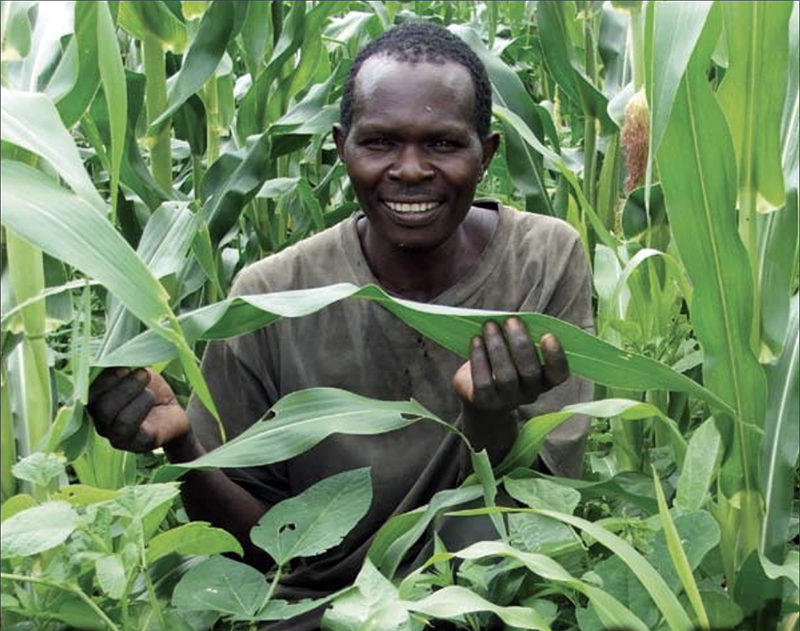
Fighting Climate Change by Putting the Regenerative into Agriculture
by Sheryl Karas, CRA staff

Photo from the cover of Restoring the Soil: A Guide for Using Green Manure / Cover Crops to Improve the Food Security of Smallholder Farmers (PDF) by Roland Bunch.
Do you want to know the most exciting thing about regenerative agriculture? It’s the word “regenerative.” It means we actually have the ability to bring seemingly dead, practically infertile soil back to life! Because the health of our soil is intrinsically related to sequestering carbon, this form of agriculture is increasingly in the news as a potential solution to combat climate change. But what it means for people facing food shortages and drought due to these changes is even more dramatic.
Through consultancies in over 50 nations with 45 different NGOs, Roland Bunch has been helping smallholder (mostly subsistence) farmers in Latin America, Asia and Africa reclaim their land and be able to feed themselves and their communities since 1983. Bunch believes that in regards to both food security and climate change, the success of these programs can help lead the way for the rest of the world.
Roland Bunch is a proponent of green manure cover crops (gm/ccs), grown together with vegetables, root crops and trees. The cover crops are plants deliberately chosen to add nutrients to the soil or to help control weeds. The term “green manure” refers to the practice of chopping down the cover crop and allowing it to decompose in place. Often farmers in other parts of the world will till this into the soil, but in poor areas farmers have no tractors or even draft animals to help with the job. This is oddly an “advantage” for them. Heavily tilling the soil disrupts the soil biology needed to convert organic matter into healthy topsoil. Unlike western farmers who are challenged to figure out how to adequately transition from conventional heavy tillage to no-till techniques, for these farmers no-till is just the most practical solution and the easiest for them to do. They grow the cover crop in between the crops they intend to harvest or plant them among fully grown crops just before those crops are harvested. They chop the cover crop down after they collect the seeds to either eat or plant next year. Then they plant their next crop after the chopped material has decomposed for a few weeks. The ground is never tilled or left bare.
Bunch says this approach is “amazingly popular in Africa. The main reason is that smallholder farmers are no longer able to fallow their land [leave it unsown for a period in order to restore its fertility] . . . because they don't have enough land anymore . . . As a result, the soil has become, over the last 30 years, tremendously degraded. This, in turn, has resulted in rainwater infiltration rates having dropped from a normal of about 60% to between 10 and 20% (according to scientific studies), which is the major cause of Africa's increasingly frequent ‘droughts.’ Yes, climate change is also having an impact, but the lack of rainwater infiltration is a much greater cause of the increase in droughts. (In many countries we now have ‘droughts’ and floods in the same years, because the rainwater is all running out of people's fields rather than filtering into the soil.)”
Using a green manure cover crop protects the soil from erosion while the roots break up heavy compaction to allow the rainwater to filter down. And by leaving the plant waste and old roots in place, and allowing the earthworms and soil microbes to break it down to create fertile new topsoil, the amount of organic matter in the soil increases year by year. This can be at a surprisingly fast rate. Bunch has documented increases of topsoil of an inch every two years on hundreds of fields surveyed in his work, even faster in some cases. Farmers who have been using these methods for 40 years now have 16 inches of topsoil composed of mostly high-quality compost.
The soil organic matter is also important when it comes to climate change. When left untilled and covered with cover or cash crops, it acts as a carbon sink for carbon dioxide drawn down from the atmosphere and converted via photosynthesis. The higher the organic matter in the soil, the better this works. Bunch believes that the potential for carbon sequestration on farms in the tropics is far greater than what can be done in more temperate climates. It doesn’t snow so they can grow cash or cover crops all year, and the heat and sunlight seems to allow soil biomass to grow more quickly.
Furthermore, there’s no need to convince these farmers of the validity of climate change and the value of “carbon farming”—carbon sequestration happens naturally after they learn to use these methods to save their farms and ways of life. Bunch says that farmers in drought-prone Africa, after about 5-6 years of using green manure cover crops have seen their maize productivity double or triple in good years and improved by 80% in drought years. Once they have seen this level of success in other fields, they’re eager to do it for themselves.
Simply focusing on getting poverty-stricken farmers in developing nations to do the carbon-farming for us, of course, isn’t good enough when it comes to combating the climate challenges the world faces. But the approach that supports their efforts is certainly transferrable. Farmers in the Midwest United States, for example, are also coping with catastrophic livelihood failures due to flooding and other extreme weather events. Risk-aversion makes the idea of changing over to regenerative techniques difficult in better times. But if you want to save the family farm as well as benefit from carbon-farming initiatives—for example, the $15 trillion being made available by Indigo Carbon(opens in new window)—Roland Bunch’s work could provide the inspiration necessary.
